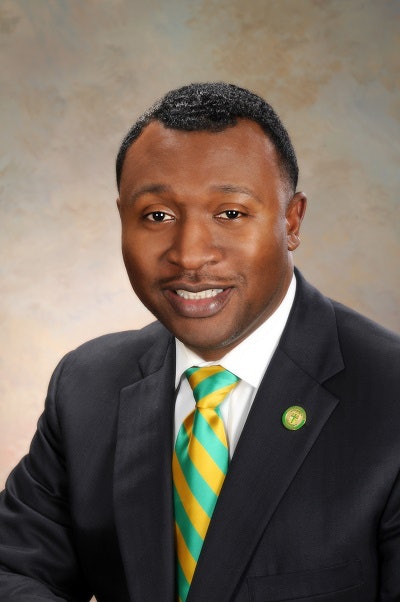As with any new year, there are hopeful prognostications of what a fresh canvas will yield. The beginning of 2020, however, seemed to hold even greater promise as it not only signaled a new decade, but the year also carried the popular metaphorical hope of “20/20 vision” – 20/20 being the generally agreed upon standard for visual acuity.
But here we are today, dealing with a public health crisis created by the novel coronavirus (COVID-19), mere months into a year that, at its onset, inspired optimism for the prospect of clarity and illuminated direction. It seems now that the only clear thing about our current reality is the uncertain and indistinct toll that is being exacted upon the higher education landscape – historically Black colleges and universities (HBCUs), in particular.
 Dr. Roderick L. Smothers, Sr.
Dr. Roderick L. Smothers, Sr.At this point no one – not government officials, public health authorities or health care professionals – can forecast how long this global pandemic and its countermeasures will last. By all accounts, COVID-19 is pervasively wreaking havoc on a social and institutional level. At my private HBCU, its impact has been substantial and far reaching – it has been very disruptive to our students, faculty and staff – in ways that are markedly different from more familiar natural disasters. All of us have found that there is no playbook for COVID-19.
Lately I have wondered – if I could have predicted COVID-19 three or four years ago – how I would have prepared differently for a public health pandemic as the president of a private, church-related HBCU. Growing up, my mother would sagely say that “hindsight is 20/20 vision.” Although we suspect that we are nowhere close to being out of the woods of this global crisis, we are still able to envision how we would have more adequately planned for the circumstances in which we now find ourselves.
Even at this juncture, I can pinpoint a few areas of readiness for which I would have a plan – in an ideal world, of course, devoid of restrictions of capital and human resources. At a minimum, with advanced warning of an aggressive public health threat, I know that I would have:
- Developed a more comprehensive disaster preparedness plan beyond the scope of common weather-related emergencies and natural disasters;
- Prioritized the need for a team of dynamic and strategic communications professionals;
- Invested more in enhancing the College’s technology infrastructure
- Established a Rainy Day Fund;
- Developed more robust student support services that can be deployed beyond a physical campus environment;
- Invested more in faculty professional development centered around instructional delivery through the use of technology; and
- Purchased Business Disruption Insurance.
As I ponder this list, I realize that – as with most things – my mother was right: Hindsight is truly perfect vision.
As it stands, because of its volatile and dangerous nature, COVID-19 has forced the College’s hand to make some abrupt decisions that have affected the student living community and unintentionally created a sense of distrust between students and administration. Furthermore, the necessary changes to pedagogical practices have created an ilk of turbulence. And the fluidity of the crisis has often caused the College’s leadership team to feel as if it is making decisions while walking in the dark. For sure, there has been very little clarity in the wake of this crisis other than to realize we were not ready for it.
It was another leader who is quoted as saying: “When written in Chinese, the word ‘crisis’ is composed of two characters. One represents danger and the other represents opportunity.” In the wake of COVID-19, President John F. Kennedy’s words presciently ring true.
When the coronavirus outbreak comes to a halt and we emerge from the state of emergency, our world will be undeniably changed. Our campuses will be changed. Our students will be changed. Our faculty and staff will be changed. When this day comes, I have to believe that through the lens of a pandemic perspective – taking into account the experiences, experiments, accommodations and adjustments we will have made – we will open the door to the opportunity for renewal.
What this will look like, when the dust settles, is a re-imagining of how we do the unique and special ministry of the HBCU. It is my hope that in addition to educating our students to be competitive in an interconnected, technologically advanced world, we will also re-energize and perhaps redefine the role of the educator, the practitioner and the administrator. In a post-coronavirus world, we would no longer be afraid of technology and will continue to harness digital tools to purposefully fold virtual learning capacity into the traditional academic environment. With the coronavirus in our rear view, HBCUs would be better equipped to continue to provide access to a quality education that will prepare and cultivate confident world leaders.
In short, the aftermath of this 2020 phenomenon known as COVID-19 is sure to offer 20/20 vision that will help guide us through any unchartered waters of the future. In the meantime, however, we take solace in knowing that we are doing the best we can, under extraordinary pressure, to seize every opportunity to strengthen our fate going forward. But today, our resolve and our faith are more acute than our vision – and we are relying on both to see us through.
Dr. Roderick L. Smothers, Sr. is President and CEO of Philander Smith College – a private historically Black institution, affiliated with the United Methodist Church, located in Little Rock, Arkansas.















